The years following World War II saw a transformation in aviation from military use to civil, commercial and, notably, agricultural applications. Agriculture has long been the foundation of Florida’s economy, and in the post-war era, a key technological advancement began to emerge within the industry: aerial agriculture. Aerial application of pesticides and seeding became prevalent in Florida as military airfields, such as Brooks Army Airfield in Brooksville and Pompano Air Park in Ft. Lauderdale, were adopted for civil use and as war surplus biplanes, such as the Stearman, were re-purposed for agricultural use. Within this rise in civil and agricultural use, State Aviation Director William C. Lazarus saw a need for tighter controls on aviation at the state level, in the form of licensing and regulation of airports, and lobbied for legislation to achieve this aim.
The State Airport Licensing Act (Chapter 24046, Florida Laws 1947), a bill to provide state licensing and regulation of airports, was passed to encourage and develop aeronautics in Florida and effected uniformity of the laws and regulations relating to the establishment and development of airports in accordance with federal aeronautics laws and regulations. The proposed rules and regulations set forth by the State Improvement Commission in 1947 were circulated to owners of existing private airports for their input.
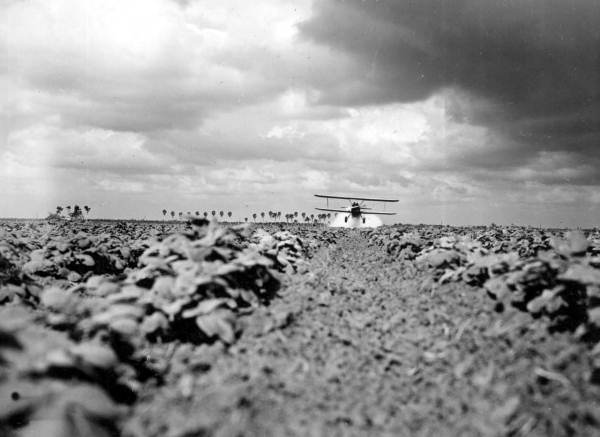
Crop dusting in Florida.
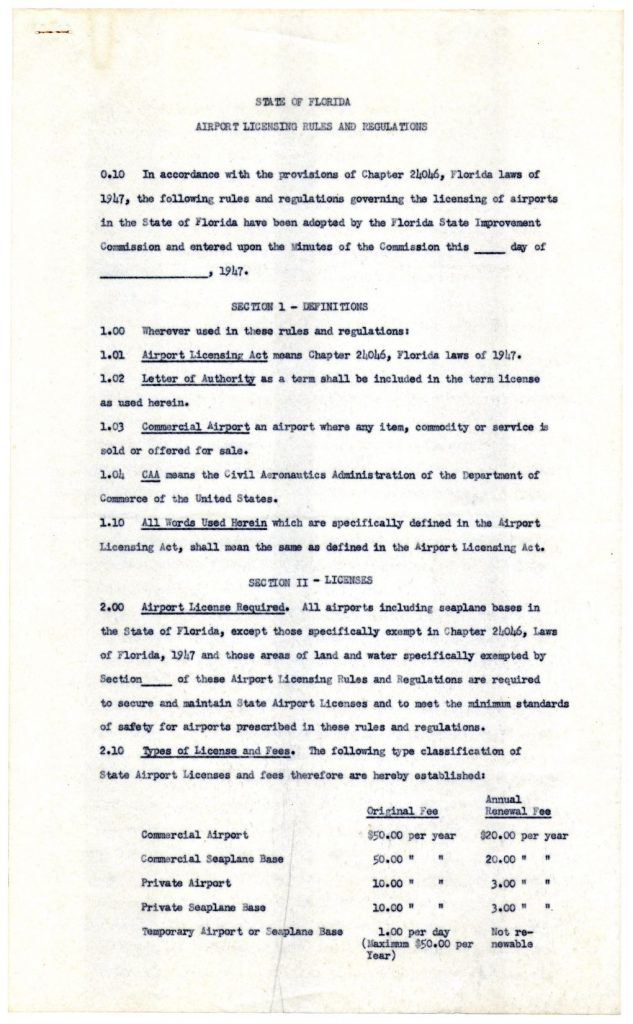
Airport Licensing Rules and Regulations set forth in accordance with State Airport Licensing Act of 1947 (Series S 284, box 1, folder 18, item 21).
Correspondence received in reaction to the rules and regulations gives insight into the pursuit of civil and agricultural aviation in Florida, given firsthand from stakeholders and enthusiasts in the industry. A.H. Lane, manager of Davis Seaplane Base, wrote the following to William Lazarus:
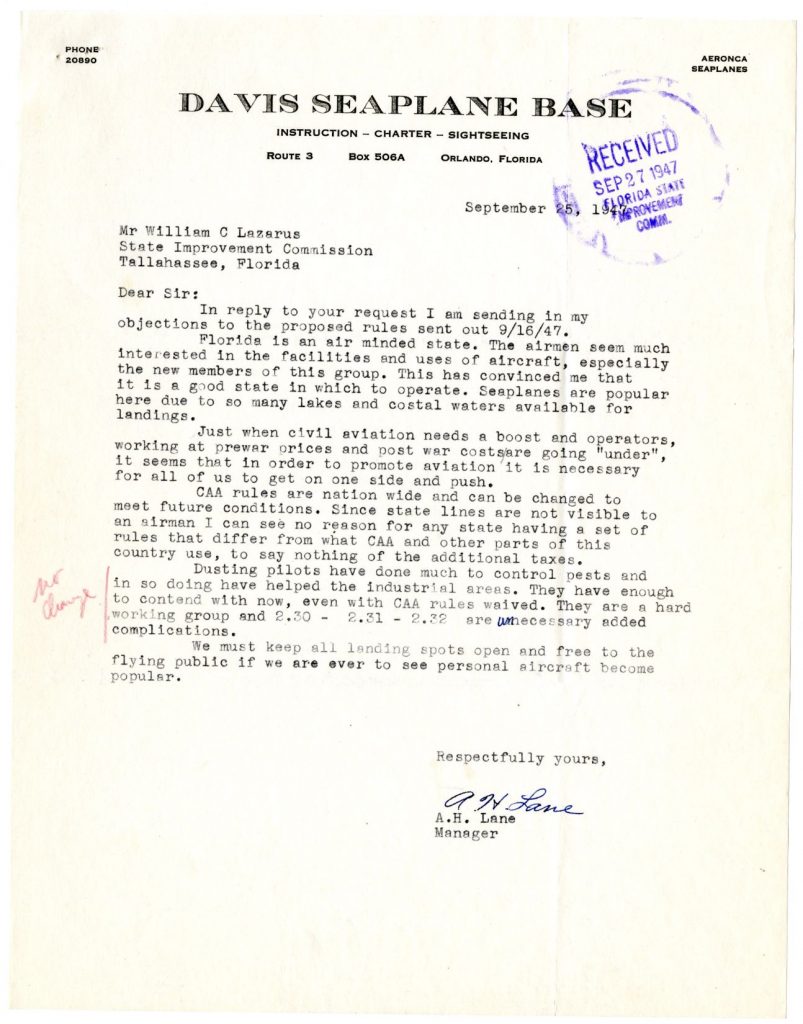
Letter from A. H. Lane expressing concern over aviation regulations, 1947 (Series 284, box 1, folder 18, item 7).
Florida is an air minded state. The airmen seem much interested in the facilities and uses of aircraft, especially the new members of this group. This has convinced me that it is a good state in which to operate. Seaplanes are popular here due to so many lakes and costal [sic] waters available for landings.
Just when civil aviation needs a boost and operators, working at prewar prices and post-war costs are going “under,” it seems that in order to promote aviation it is necessary for all of us to get on one side and push.
Further, Lane’s letter emphasizes the role of crop dusting pilots in Florida’s agricultural sector and expresses anxieties over the impact of regulation on their business:
Dusting pilots have done much to control pests and in so doing have helped the industrial areas. They have enough to contend with now, even with CAA rules waived. They are a hard working group and 2.30 – 2.31 – 2.32 are unnecessary added complications.
We must keep all landing spots open and free to the flying public if we are ever to see personal aircraft become popular.
Lane wasn’t alone in his concern over the act’s impact on agriculture. Many crop dusting companies wrote in objection to regulations on the width of airstrips (a newly imposed minimum of 300 feet.) Crop dusters argued that a strip of this width would not be feasible in rural areas and that dusting planes had to land and take off close to the fields. A letter from J. R. McDaniel of McDaniel Dusting Service described in detail the procedures of crop dusting and expressed concern over the plight of the farmer in Florida as related to regulations set forth on crop dusting:

Letter from J.R. McDaniel to William C. Lazarus, outlining concerns about the impact of the State Airport Licensing Act on crop dusting procedures, page 1 (Series S 284, box 1, folder 21, item 6).
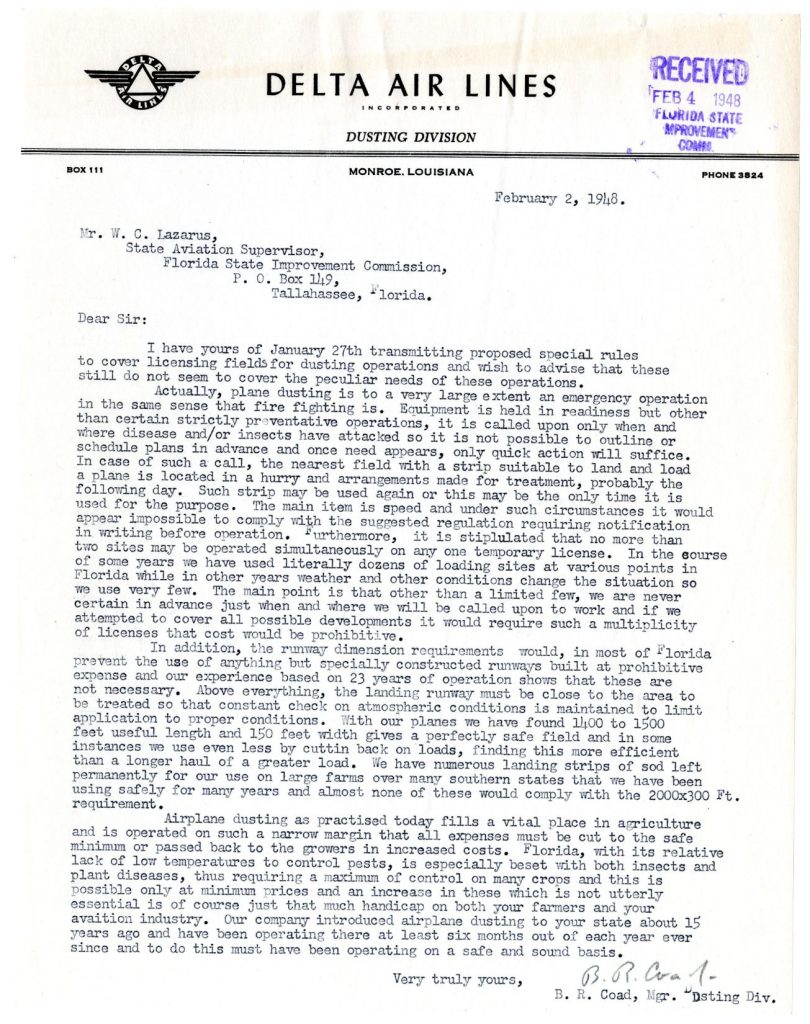
Letter from Delta Air Lines Dusting Division to William C. Lazarus expressing concern over sections of the State Airport Licensing Act that would affect crop dusting operations (Series S 284, box 1, folder 21, item 7).
Many companies also expressed criticism of the gross weight limit of two tons put forth for use of Class I airports under the initially proposed rules and regulations. At the outcry of corporations such as United States Sugar and Showalter, as well as special interest organizations, the commission dropped the regulations that limited gross weight of airplanes on certain airports.

Letter from U.S. Sugar to William C. Lazarus expressing concern over regulations on the weight of aircrafts (Series S 284, box 1, folder 18, item 11).
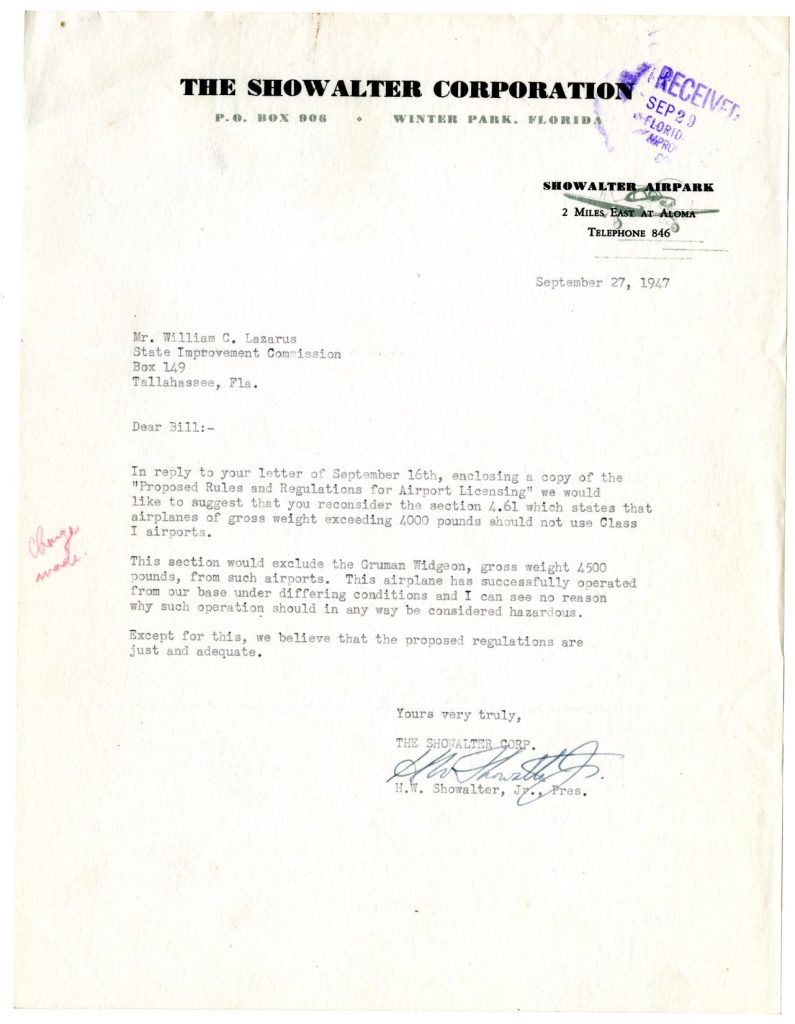
Letter from H.W. Showalter, Jr. expressing concern over regulations on the gross weight of planes, 1947 (Series S 284, box 1, folder 18, item 12).
Despite public concerns over the regulations’ impact on agriculture, the State Airport Licensing Act was in many respects lenient so as to encourage aviation in the state. No approvals were required for the sites of existing airports, meaning airstrips used by farms and other private operations were grandfathered into the act.
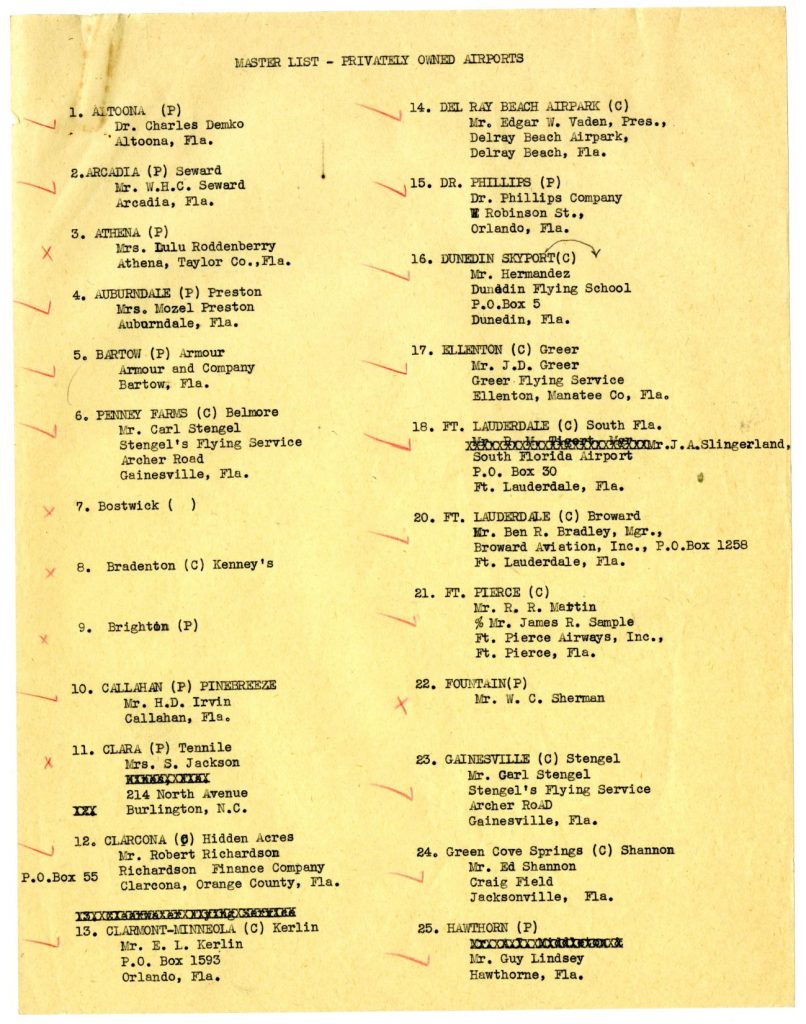
Master list of privately owned airports and seaplane bases, 1947, page 1 (Series S 284, box 1, folder 7, item 3).
Licensing for new airstrips was decidedly inexpensive. The section of the act providing for the licensing of airports deemed that a fee not to exceed $50.00 (the equivalent of $561.00 in 2017) would be charged for the approval of airport licensing, while renewals of licenses were not to exceed $10.00.

Airport licenses issued from 1947 to 1948 (Series S 284, Box 1, Folder 8, item 14, page 2 of 5).
Correspondence relating to the submission of these fees to the Florida State Improvement Commission gives a rare glimpse into the operations of now-defunct private aeronautic small businesses, such as Stone and Wells Flying Service of Jacksonville.
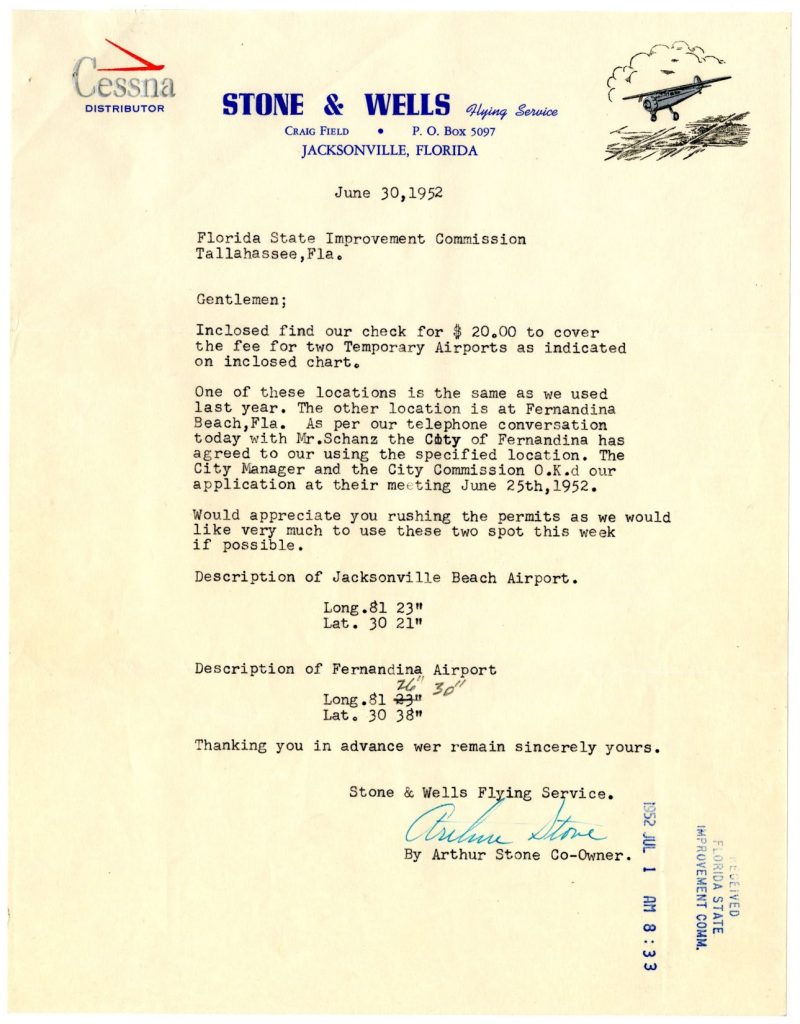
Letter, Stone and Wells Flying Service to Florida State Improvement Commission, enclosing licensing fee for temporary airports at Jacksonville Beach and Fernandina Beach (Series S 284, box 1, folder 54, item 7, page 1).

Flight chart for temporary airport locations in Jacksonville Beach and Fernandina Beach (Series S 284, box 1, folder 54, item 7).
Though there are new laws and regulations governing aviation in Florida, the State Airport Licensing Act was one of the first laws to require the inspection, approval, registration and licensure of air strips and airports and to regulate air traffic. Cited as the first law in the history note of most sections of the current Florida Statutes on regulation of Aircraft and Airports, the Act has shaped many of today’s laws governing aviation.
Records from series S284 Aviation Division Administrative Records, 1947-1959, give rare insights into the post-war history of aviation in Florida, including licensing of private and commercial airstrips and airports, airport rules and regulations, and regulations regarding crop dusting. License and master airport lists included in this series contain valuable information for genealogists whose families may have been involved in aviation in Florida. Historians with an interest in aviation in Florida will find this series as well as collection M82-133 William C. Lazarus Papers, of use in their research.
Sources:
S284 Aviation Division Administrative Records, 1947-1959, Box 1, State Archives of Florida, Tallahassee, Florida.
Brown, W. J. (1994). Florida’s Aviation History: The First One Hundred Years. Largo, FL: Aero-Medical Consultants.











 Listen: The Folk Program
Listen: The Folk Program